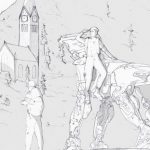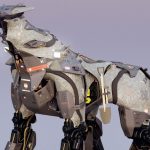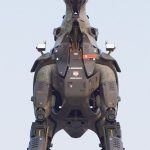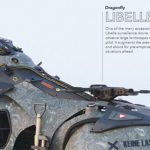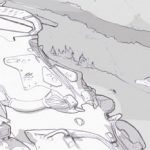Noriker is a futuristic, heavy-duty robotic machine concept that looks like a giant monster machine. It’s a creative interpretation from Cristoph Sokol, UK based creative designer, where sometime in the future, Noriker would become part of military forces of Swiss and Austria. The head part of Noriker reminds us to Stich from Lilo&Stitch, a cute little monster. Cristoph also created a cool fictional storyboard to complement the design. Read the story below.
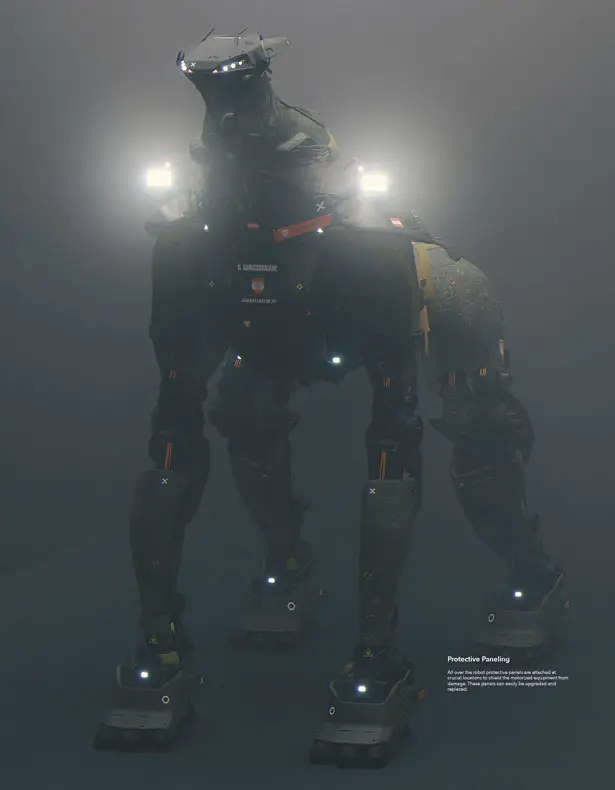
In 2020 Steyr Motors and Steyr Mannlicher AG came together to start a joint venture to design and manufacture autonomous robotic systems. Steyr Robotik was created. The newly found company settled down and constructed its headquarters in the town of Steyr in Austria.
The plan for the future of the company consisted in creating a highly automated and state of the art production facility in the heart of Austria where the design and production for autonomous and non-tactical systems would be realized. The purpose of these systems is to assist civil or military bodies in the overcoming of environmental disasters. Flooding, avalanches or hurricanes create scenarios where the infrastructure might get damaged to a point where traditional vehicles don’t have access. It is in these situations that the Steyr Autonomous Systems are applied and can provide people with the help needed and eventually save lives.
Steyr Robotik was found by Steyr Motors and Steyr Mannlicher AG to develop autonomous systems that can enter and overcome traditionally inaccessible terrain. Steyr Motors initially Steyer-DAimler-Puch AG manufactured various vehicles for the private and military sector. Most important was the range of off-road vehicles with the two most prominent vehicles the Haflinger and the Pinzgauer. Today the Steyr-Daimler-Puch AG is split up into many different companies.
The companies new headquarter is located out-side of the town of Steyr and can be found on a hillside. A visitor will first encounter the two glass cuboids that serve as the reception for external clients and the office spaces above. The employees make their way down into the highly automated and state of the art production hall where the products are built. Some design and engineering work is located in studio spaces in town. Behind the building a track and testing space is located where the various prototypes are put to the test and to exceed their limitations.
The manufacturing and office spaces where conceptualized to use minimal physical labor and rely on highly autonomous equipment most of which is designed and engineered and sold to the wider market by the company itself.


Pinzgauer was originally developed in the late 1960s and manufactured by Steyr-Daimler-Puch of Graz, Austria, and was named after the Pinzgauer (Noriker), an Austrian breed of horse.
The Pinzgauer first generation model (710, 712) was produced until 2000 by Steyr-Daimler-Puch in the city of Graz, Austria. It was, and is in use many armies around the world like Austria, Switzerland, United Kingdom, Saudi Arabia, Thailand, Albania, and Bolivia. When Austrian millionaire Mr. Stronach took over the shareholder majority of Steyr-Daimler-Puch off road vehicles; he gave the right to build the Steyr Pinzgauer to Automotive Technik Ltd (now BAE). As of 2009, in the Graz plant, the Mercedes Benz G Wagon / Puch G off-road vehicles were being built.

The Pinzgauer is one of the most capable all-terrain vehicles ever made. While not as fast on-road (110km per hour or 68mph) as an American Humvee, it can carry more troops, and move faster over rough trails.
Many Pinzgauers were sold to military forces (initially Austrian and Swiss) to be used as non-tactical utility vehicles. Typical military roles are as general-purpose utility truck, command vehicles, troop carrier, ambulance, and tow vehicle. Roles very similar to other civilian sourced vehicles like Land Rover in the UK, the Blazer CUCV in the US, and the Mercedes G in many European countries.
Noriker features quadrupedal design that allows easy access to traditionally inaccessible terrain. Avalanches, hurricanes or other environmental disasters can create an environment that isn’t well suited for wheels. It is equipped with road legal light systems to allow easy movement and mobility all around. Noriker is futuristic robot that becomes the flagship of the autonomous systems range and is used as the multipurpose captain of the fleet. Its purpose built AI allows it to act autonomously when needed.
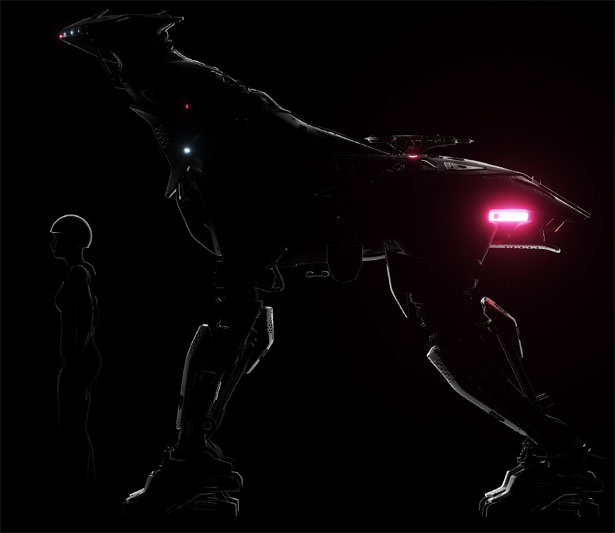
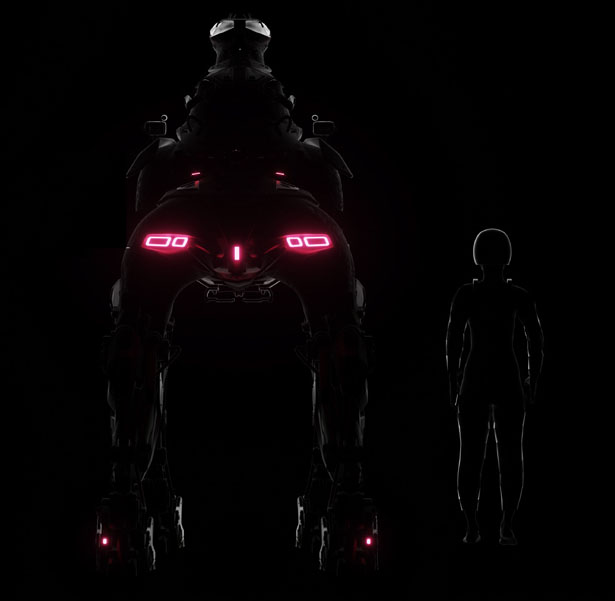
Accessing remote villages and towns are hit by environmental disasters and cut off from infrastructure are the main fields of operations. After first aid provided through helicopter use the Steyr Autonomous Systems are the workhorses on the ground that assist with clean up, rebuilding of infrastructure and delivery of essential goods.
With 3.1 meters height and 3.35 meter length, Noriker is a heavy workhorse that can deliver enough force to remove heavy rocks, fallen trees, and vast amount of debris and snow. Different set ups allow the Noriker to carry up to 2.5 tons of goods or a varying amount of individuals. Autonomously or in combination with highly skilled pilot. The Noriker excels in every situations.
The main computers are located in the highly protected head of the robot. These sets of computers power the state of the art machine intelligence. Extra computing power is located in the main body of the robot behind the protective body panels. The most part of the exterior is covered in extremely durable Kevlar cloth. Its smart fibers can adjust the camouflage pattern color in seconds. The Noriker can easily blend into any environment if necessary.
The fog beams of Noriker are removable and interchangeable depending on the requirements. All over this robot protective panels are attached at crucial locations to shield the motorized equipment from damage. These panels can easily be upgraded and replaced.
The Noriker is equipped with a vast amount of sensory and light systems. Two heavy beams on each shoulder panel allow for far reaching visibility in extreme weather conditions. The protective panels are located at crucial and important parts around the body of the Noriker.
One of the many accessories for the Noriker is the Libelle surveillance drone. It is able to autonomously observe large landscapes or be accessed remotely by the pilot. It augments the area of operation of the Noriker and allows for pre-emptive assessments of the unknown situations ahead.
The pilot can easily access the drone through the Augmented Reality headset to get a clearer picture of the surrounding environment. This feature can also be used to remote access into the Noriker itself. This allows to constantly have control over the robot or allow to manually override an action by piloting the robot through rough terrain.
More images of Futuristic Noriker All-Terrain Robot Machine:
